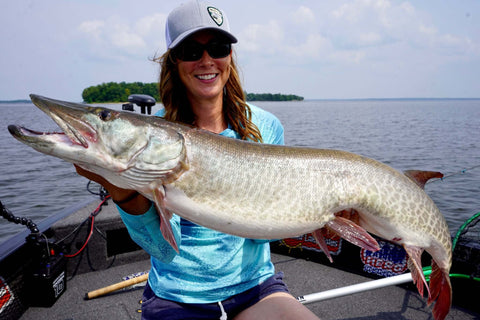
BY TYLER & SARA TRAMPE
Whether you are a new musky angler, a weekend warrior, or a seasoned veteran, handling these fish from catch to release is important to maintain the ecosystems and preserve the waters for years to come.
Musky fishing is truly sport fishing, not sought after for nourishment, or any other purpose than entertainment. Musky are not prolific spawners; which means it takes a long time to reach spawning age; which in turn means a mature musky is older, took years to reach its size, and won’t be replaced in the system for many years if something happens to it on your release. Therefore, it is even more important to handle these trophies with proper care. Correct handling can mean the difference between life and death for the fish.
Proper Equipment
There are many videos, discussions, and thought processes on exactly how to properly handle musky. As soon as you decide to target musky there are a few things you need before you even hit the water. You should have a large net (we like the Beckman BN3244C), long-handled pliers, and a quality set of hook cutters in the boat, readily available. If you plan on targeting musky, you should absolutely be aware of how to hold and release these fish with the proper equipment on board.

Note: if water temps exceed temperatures of 80 F the mortality rate increases exponentially of caught and stressed fish. Fishing for muskies in these conditions is highly discouraged.
The Catch & Net
First, it’s imperative to remember once you have scooped the net and have a musky in the bag you are responsible for the fish. Make sure the fish is laying horizontally in the net with its head under the water.
It is easy to get hooks tangled where the musky lays at an odd angle with its head out of the water, rendering them unable to breathe and placing undue pressure on their face.

Either shake the hooks free from the net, or remove the hooks from the fish immediately. Netting is an art form, and with experience you will get better and have less mishaps to shorten your time with the fish.
Handling
Once the fish is safely in the net – for the angler and the fish – you can take a moment and gather all things needed for a great photo.

If you don’t want a photo, unhook the fish boat side without ever removing it from the water. If you have not removed the hooks yet, gather your pliers and hook cutters; I strongly recommend wearing glasses to protect your eyes until all hooks are removed. Cutting hooks to safely remove them is the least stressful for the fish, but if you can easily pop out the hooks with a pliers, do so and then move your bait away from the net.

If you want to measure or weigh your fish try to do it while the fish is in the net. It isn’t necessary to weigh or measure every fish. Set personal goals, but don’t let pressures from outside influences create the unnecessary need to document exact measurements every time.
Note: Get your bump board/measuring tool wet first then place the fish on the device. This helps protect the fish's slime coating and from external heat which metal boards can gather in long periods of sunlight.
When you are ready to pick up your fish, wet your hand and slide your fingers behind the gill plate up to the bottom jaw (not in the gills, as they are very sensitive). Then, pinch your thumb and fingers together on opposite sides of the skin. Hold the head of the musky with your dominant hand to have the most control over the fish, quickly lift the fish out of the net, and get your opposite hand under the belly supporting the fish in a horizontal, natural position. It is important to hold the fish horizontal to avoid pressure on their skeletal system from hanging vertically.

If the fish thrashes – and they will thrash – hold tightly and do not drop the fish. If you cannot hold on, let the fish fall back into the water and not onto the bottom of the boat. Protect the fish’s head as best as possible if it falls to the boat floor. Try not to use gloves or towels and hold the fish away from your body, any contact removes the slimy, protective layer that helps protect from bacteria. Keep a firm grip, take a few quick pictures, and get the fish back in the water. If you need more time, place the fish back into the net to let it breathe and then pick it back up.
The Release
Musky typically require recovery time on release due to lactic acid build up from the fight.

On any large, heavy fish I have my boat partner help me hold the tail of the fish as I lower it back into the water. I do this in order to keep a firm grip to make sure I don't drop it. Fish are slippery and any thrashing when you are lowering them can cause them to quickly slip out of your reach. While holding the tail, place minimum pressure under their belly until they have re-orientated themselves. When the tail begins moving the musky is ready to independently swim off. If you release the fish too early it could flip over belly up and sink to the bottom. Just because the fish is in the water does not mean it was a safe release.







My first musky was 3 weeks ago . On light line with no leader and the fish jumped 2 times in the water and one out of the net. The fight lasted about 20 minutes and the power of the fish trying to unhook it was crazzzzzy . We did a couple quick pictures and then a release. It recovered quickly and swam away without help. Estimate length was 40 inches and thick body so estimated weight was 20 lbs.
Leave a comment